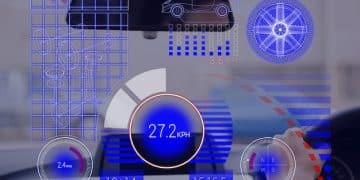Predictive Maintenance: Using AI to Prevent Car Repairs

Predictive maintenance uses artificial intelligence to analyze vehicle data and predict potential failures, enabling timely repairs that can prevent costly breakdowns and extend the lifespan of your car.
Imagine if your car could tell you when it needs a repair *before* it breaks down, saving you from expensive surprises and roadside emergencies. That’s the power of predictive maintenance, and it’s quickly becoming a reality thanks to advancements in artificial intelligence.
Understanding Predictive Maintenance in Auto Technology
Predictive maintenance is a proactive strategy that leverages data analysis and machine learning to forecast potential equipment failures. In the context of auto technology, this means using sensor data, driving patterns, and historical repair records to identify when a vehicle component is likely to fail.
By implementing predictive maintenance, car owners and fleet managers can schedule maintenance tasks at optimal times, reducing the risk of unexpected breakdowns and minimizing downtime. This approach not only saves money on repairs but also enhances vehicle safety and reliability.
How Predictive Maintenance Works
Predictive maintenance systems rely on several key components to function effectively:
- Sensors and Data Acquisition: Vehicles are equipped with sensors that collect real-time data on various parameters, such as engine temperature, oil pressure, and brake performance.
- Data Analysis: The collected data is analyzed using advanced algorithms and machine learning models to identify patterns and anomalies that indicate potential failures.
- Predictive Models: These models are trained on historical data and failure patterns to predict the remaining useful life (RUL) of vehicle components.
- Maintenance Scheduling: Based on the predictions, maintenance tasks are scheduled proactively to address potential issues before they escalate into major problems.

The use of predictive maintenance in auto technology represents a significant shift from reactive maintenance strategies, where repairs are performed only after a breakdown occurs. By anticipating and addressing potential problems early, predictive maintenance helps to ensure vehicle reliability, safety, and cost-effectiveness.
The Role of AI in Predicting Car Repairs
Artificial intelligence is at the heart of modern predictive maintenance systems. AI algorithms can process vast amounts of data from various sources to identify subtle patterns and predict potential failures with a high degree of accuracy. This capability is particularly valuable in the automotive industry, where vehicles are complex systems with numerous interconnected components.
AI algorithms can learn from historical data, adapt to changing conditions, and continuously improve their predictive capabilities. This makes them well-suited for predicting car repairs, where numerous factors can influence the likelihood of a failure.
AI Techniques Used in Predictive Maintenance
Several AI techniques are commonly used in predictive maintenance for car repairs:
- Machine Learning: Algorithms like regression, classification, and clustering are used to analyze vehicle data and predict the likelihood of specific failures.
- Deep Learning: Neural networks can process complex data patterns and identify subtle indicators of potential problems.
- Natural Language Processing (NLP): NLP can analyze textual data from maintenance records, repair logs, and diagnostic reports to extract valuable insights and identify recurring issues.
AI-powered predictive maintenance systems can analyze data from various sources, including onboard sensors, driver behavior, and environmental conditions, to provide a comprehensive view of vehicle health. This information can then be used to identify potential problems and schedule maintenance tasks at optimal times.
Benefits of AI-Driven Predictive Maintenance
The adoption of AI-driven predictive maintenance offers numerous benefits for car owners, fleet managers, and the automotive industry as a whole. By anticipating and preventing potential failures, predictive maintenance can save time, money, and enhance vehicle safety.
From reducing unexpected breakdowns to optimizing maintenance schedules, the advantages of AI-driven predictive maintenance are substantial and far-reaching. Let’s take a look at some of the biggest benefits.
Reduced Downtime and Repair Costs
One of the primary benefits of AI-driven predictive maintenance is the reduction in downtime and repair costs. By identifying potential issues early, maintenance tasks can be scheduled proactively, avoiding costly breakdowns and minimizing vehicle downtime. Here are a few examples:
- Early Detection: AI algorithms can detect subtle anomalies in vehicle data that indicate potential problems before they escalate into major failures.
- Preventative Maintenance: By scheduling maintenance tasks at optimal times, car owners can avoid costly repairs and extend the lifespan of their vehicles.
- Optimized Schedules: Predictive maintenance systems can optimize maintenance schedules based on vehicle usage, driving conditions, and environmental factors.
By reducing downtime and repair costs, AI-driven predictive maintenance can improve the overall cost-effectiveness of vehicle ownership and fleet management. Car owners can save money on repairs, while fleet managers can increase vehicle uptime and productivity.
Implementing Predictive Maintenance in Your Car
While advanced predictive maintenance systems are typically integrated into modern vehicles, there are also aftermarket solutions that can be implemented in older cars. These solutions typically involve installing sensors, connecting to a data analysis platform, and receiving alerts and recommendations through a mobile app.
Whether you own a brand-new vehicle or a reliable older car, there are options available to take advantage of the benefits of predictive maintenance. Let’s explore a few steps you can take to implement predictive maintenance in your car.
Aftermarket Predictive Maintenance Solutions
For car owners with older vehicles that do not have built-in predictive maintenance capabilities, several aftermarket solutions are available:
- OBD-II Scanners: These devices plug into the car’s OBD-II port and provide real-time data on various parameters, which can be analyzed using mobile apps or software.
- Connected Car Devices: These devices offer a range of features, including vehicle tracking, driver behavior monitoring, and predictive maintenance alerts.
- Mobile Apps: Several mobile apps are available that can connect to your car’s data and provide maintenance recommendations based on AI-driven analysis.

By implementing aftermarket predictive maintenance solutions, car owners can gain valuable insights into their vehicle’s health and proactively address potential issues before they escalate into major problems. These solutions empower car owners to take control of their vehicle’s maintenance and ensure its reliability and longevity.
Challenges and Future Trends in Predictive Maintenance
While predictive maintenance offers numerous benefits, there are also challenges that need to be addressed to ensure its widespread adoption. Data security and privacy are major concerns.
Despite these challenges, the future of predictive maintenance in the automotive industry looks promising, with ongoing advancements in AI, sensor technology, and data analytics. Here are some significant areas of development.
Data Security and Privacy Concerns
One of the main obstacles to the widespread adoption of predictive maintenance is data security and privacy concerns. Predictive maintenance systems collect vast amounts of data on vehicle usage, driving behavior, and maintenance history, which can be highly sensitive. Therefore, it is important to take the appropriate security measures.
Addressing these concerns will be crucial to building trust and ensuring the responsible use of predictive maintenance technologies.
- Data Encryption: Protecting sensitive data with strong encryption techniques.
- Data Anonymization: Removing personally identifiable information from data sets.
- Access Controls: Implementing strict access controls to limit who can access and use vehicle data.
The Future of Car Care: AI, Predictive Maintenance, and You
As technology continues to evolve, AI-driven predictive maintenance is poised to transform the way we care for our cars. The ability to anticipate and prevent potential failures before they occur is not just a convenience but a fundamental shift in how we approach vehicle maintenance. This proactive approach promises to save time, money, and hassle.
The future of car care is intelligent, proactive, and user-friendly, empowering drivers and fleet managers alike to optimize vehicle performance and longevity.
By leveraging the power of AI, predictive maintenance systems will enhance the reliability, safety, and cost-effectiveness of vehicle ownership. As these technologies continue to evolve, they promise to revolutionize the auto industry and improve the overall driving experience.
| Key Benefits | Brief Description |
|---|---|
| 🔧 Reduced Downtime | AI predicts failures, minimizing unexpected breakdowns. |
| 💰 Cost Savings | Proactive maintenance prevents expensive repairs. |
| 📈 Enhanced Reliability | Ensures vehicle health and extends lifespan. |
| 🛡️ Improved Safety | Early issue detection enhances vehicle safety. |
Frequently Asked Questions
Predictive maintenance uses data and AI to forecast car component failures. This allows for timely repairs, preventing major malfunctions and reducing costs.
AI analyzes real-time data from sensors, driving patterns, and maintenance history. This helps identify potential issues before they become significant problems.
Benefits include reduced downtime, lower repair costs, improved vehicle reliability, and enhanced safety. It optimizes maintenance schedules and prevents unexpected breakdowns.
Yes, aftermarket solutions like OBD-II scanners and connected car devices can add predictive maintenance capabilities to older vehicles. These provide data and alerts.
Future trends include advanced AI algorithms, improved sensor technology, and enhanced data analytics, all aimed at better predicting and preventing car repairs proactively.
Conclusion
In conclusion, predictive maintenance, powered by AI, is revolutionizing car care by enabling proactive maintenance and preventing costly repairs. As technology advances, embracing these innovations will ensure safer, more reliable, and cost-effective vehicle ownership.





